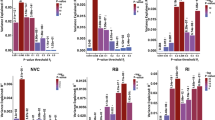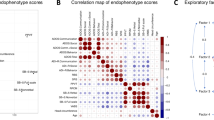Abstract
Autism spectrum disorder (ASD) is a behaviorally defined condition that manifests in infancy or early childhood as deficits in communication skills and social interactions. Often, restricted and repetitive behaviors (RRBs) accompany this disorder. ASD is polygenic and genetically complex, so we hypothesized that focusing analyses on intermediate core component phenotypes, such as RRBs, can reduce genetic heterogeneity and improve statistical power. Applying this approach, we mined Caucasian genome-wide association studies (GWAS) data from two of the largest ASD family cohorts, the Autism Genetics Resource Exchange and Autism Genome Project (AGP). Of the 12 RRBs measured by the Autism Diagnostic Interview-Revised, seven were found to be significantly familial and substantially variable, and hence, were tested for genome-wide association in 3104 ASD-affected children from 2045 families. Using a stringent significance threshold (P<7.1 × 10−9), GWAS in the AGP revealed an association between ‘the degree of the repetitive use of objects or interest in parts of objects’ and rs2898883 (P<6.8 × 10−9), which resides within the sixth intron of PHB. To identify the candidate target genes of the associated single-nucleotide polymorphisms at that locus, we applied chromosome conformation studies in developing human brains and implicated three additional genes: SLC35B1, CALCOCO2 and DLX3. Gene expression, brain imaging and fetal brain expression quantitative trait locus studies prioritize SLC35B1 and PHB. These analyses indicate that GWAS of single heritable features of genetically complex disorders followed by chromosome conformation studies in relevant tissues can be successful in revealing novel risk genes for single core features of ASD.
This is a preview of subscription content, access via your institution
Access options
Subscribe to this journal
Receive 12 print issues and online access
$259.00 per year
only $21.58 per issue
Buy this article
- Purchase on Springer Link
- Instant access to full article PDF
Prices may be subject to local taxes which are calculated during checkout



Similar content being viewed by others
References
Kanner L . Autistic disturbances of affective contact. Nervous Child 1943; 2: 217–250.
Association AP (ed). DSM-5. Diagnostic and Statistical Manual of Mental Disorders, 5th edn. American Psychiatric Association: Washington DC, 2013.
Lord C, Rutter M, Couteur AL . Autism Diagnostic Interview-Revised: a revised version of a diagnostic interview for caregivers of individuals with possible pervasive developmental disorders. J Autism Dev Disord 1994; 24: 659–685.
CfDCaP. CDC . Prevalence of autism spectrum disorder among children aged 8 years - autism and developmental disabilities monitoring network, 11 sites, United States, 2010. Morbid Mortality Wkly Rep 2014; 63: 1–21.
Bailey AJ, Couteur AL, Gottesman I, Bolton P, Simonoff E, Yuzda E et al. Autism as a strongly genetic disorder: evidence from a British twin study. Psychol Med 1995; 25: 63–77.
Hallmayer J, Cleveland S, Torres A, Phillips J, Cohen B, Torigoe T et al. Genetic heritability and shared environmental factors among twin pairs with autism. Arch Gen Psychiatry 2011; 68: 1095–1102.
Cantor RM . Molecular genetics of autism. Curr Psychiatry Rep 2009; 11: 137–142.
Purcell SM, Moran JL, Fromer M, Ruderfer D, Solovieff N, Roussos P et al. A polygenic burden of rare disruptive mutations in schizophrenia. Nature 2014; 506: 185–190.
Cantor RM . Autism endophenotypes and quantitative trait loci. In: Amaral D, Dawson G, Geschwind DH (eds). Autism Spectrum Disorders. Oxford University Press: New York, 2011, pp 690–704.
Geschwind DH, Sowinski J, Lord C, Iversen P, Shestack J, Jones P et al. The autism genetic resourse: a resource for the study of autism and related neuropsychiatric conditions. Hum Genet 2001; 69: 463–466.
Alarcon M, Cantor RM, Liu J, Gilliam TC, Geschwind DH . Evidence for a language quantitative trait locus on chromosome 7q in multiplex autism families. Am J Hum Genet 2002; 70: 60–71.
Alarcon M, Abrahams BS, Stone JL, Duvall JA, Perederiy JV, Bomar JM et al. Linkage, association, and gene-expression analyses identify CNTNAP2 as an autism-susceptibility gene. Am J Hum Genet 2008; 82: 1.
Chen GK, Kono N, Geschwind DH, Cantor RM . Quantitative trait locus analysis of nonverbal communication in autism spectrum disorder. Mol Psychiatry 2006; 11: 214–220.
Lu A-H, Yoon J, Geschwind DH, Cantor RM . QTL replication and targeted association highlight the nerve growth factor gene for nonverbal communication deficits in autism spectrum disorders. Molecular Psychiatry 2011; 18: 226–235.
Lowe JK, Werling DW, Constantino JN, Cantor RM, Geschwind DH . Quantitative linkage analysis to the autism endophenotype social responsiveness identifies genome-wide significant linkage to two regions on chromosome 8. Am J Psychiatry 2014; 172: 266–275.
Geschwind DH . Autism: many genes, common pathways? Cell 2008; 135: 391–395.
Robinson EB, Pourcain BS, Anttila V, Kosmicki JA, Bulik-Sullivan B, Grove J et al. Genetic risk for autism spectrum disorders and neuropsychiatric variation in the general population. Nat Genet 2015; 48: 552–555.
Shao Y, Cuccaro M, Hauser E, Raiford K, Menold M, Wolpert C et al. Fine mapping of autistic disorder to chromosome 15q11-q13 by use of phenotypic subtypes. Am J Hum Genet 2003; 72: 539–548.
Brune CW, Kim S-J, Salt J, Leventhal BL, Lord C, Cook EH . 5-HTTLPR genotype-specific phenotype in children and adolescents with autism. Am J Psychiatry 2006; 163: 2148–2156.
Lewis M, Kim S-J . The pathophysiology of restricted repetitive behavior. J Neurodevelop Disord 2009; 1: 114–132.
Cuccaro ML, Shao Y, Grubber J, Slifer M, Wolpert CM, Donnelly SL et al. Factor analysis of restricted and repetitive behaviors in autism using the autism diagnostic interview-R. Child Psychiatry Hum Dev 2003; 34: 3–17.
Bishop SL, Hus V, Duncan A, Huerta M, Gotham K, Pickles A et al. Subcategories of restricted and repetitive behaviors in children with autism spectrum disorders. J Autism Dev Disord 2013; 43: 1287–1297.
Cannon DS, Miller JS, Robison RJ, Villalobos ME, Wahmhoff NK, Allen-Brady K et al. Genome-wide linkage analyses of two repetitive behavior phenotypes in Utah pedigrees with autism spectrum disorders. Mol Autism 2010; 1: 1–3.
Tao Y, Gao H, Ackerman B, Guo W, Saffen D, Shugart YY . Evidence for contribution of common genetic variants within chromosome 8p21.2-8p21.1 to restricted and repetitive behaviors in autism spectrum disorders. BMC Genomics 2016; 17: 163.
Zhou X, Stephens M . Genome-wide efficient mixed model analysis for association studies. Nat Genet 2012; 44: 821–824.
Simons Simplex Colletion. 2011. Available at: https://sfari.org/resources/autism-cohorts/simons-simplex-collection.
Eu-Ahsunthornwattana J, Miller EN, Fakiola M, Jeronimo SMB, Blackwell JM, Cordell HJ . Comparison of methods to account for relatedness in genome-wide association studies with family-based data. PLOS Genet 2014; 10: e1004445.
Szatmari P, Paterson AD, Zwaigenbaum L, Roberts W, Brian J, Liu X-Q et al. Mapping autism risk loci using genetic linkage and chromosomal rearrangements. Nat Genet 2007; 39: 319–328.
Won H, Ldl Torre-Ubieta, Stein JL, Parikshak NN, Huang J, Opland CK et al. Chromosome conformation elucidates regulatory relationships in developing human brain. Nature 2016; 538: 523–527.
Kang HM, Sul JH, Service SK, Zaitlen NA, Kong S-y, Freimer NB et al. Variance component model to account for sample structure in genome-wide association studies. Nat Genet 2010; 42: 348–354.
Hormozdiari F, Kichaev G, Yang W-Y, Pasaniuc B, Eskin E . Identification of causal genes for complex traits. Bioinformatics 2015; 31: 206–213.
Hormozdiari F, Kostem E, Kang EY, Pasaniuc B, Eskin E . CAVIAR: Causal Variants Identication in Associated Regions. 2014. Available at: http://genetics.cs.ucla.edu/caviar/.
Novak NM, Stein JL, Medland SE, Hibar DP, Thompson PM, Toga AW . EnigmaVis: online interactive visualization of genome-wide association studies of the Enhancing NeuroImaging Genetics through Meta-Analysis (ENIGMA) consortium. Twin Res Hum Genet 2012; 15: 414–418.
Stone JL, Merriman B, Cantor RM, Geschwind DH, Nelson SF . High density SNP association study of a major autism linkage region on chromosome 17. Human Molecular Genetics 2007; 16: 704–715.
Cantor RM, Kono N, Duvall JA, Alvarez-Retuerto A, Stone JL, Alarcon M et al. Replication of autism linkage: fine-mapping peak at 17q21. Human Genet 2005; 76: 1050–1056.
Merkwirth C, Dargazanli S, Tatsuta T, Geimer S, Lower B, Wunderlich FT et al. Prohibitins control cell proliferation and apoptosis by regulating OPA1-dependent cristae morphogenesis in mitochondria. Genes Dev 2008; 22: 476–488.
Merkwirth C, Martinelli P, Korwitz A, Morbin M, Bronneke HS, Jordan SD et al. Loss of prohibitin membrane scaffolds impairs mitochondrial architecture and leads to Tau hyperphosphorylation and neurodegeneration. PLOS Genet 2012; 8: 11.
Zhou P, Qian L, D'Aurelio M, Cho S, Wang G, Manfredi G et al. Prohibitin reduces mitochondrial free radical production and protects brain cells from different injury modalities. J Neurosci 2012; 32: 583–592.
Jo C, Gundemir S, Pritchard S, Jin YN, Rahman I, Johnson GVW Nrf2 . reduces levels of phosphorylated tau protein by inducing autophagy adaptor protein NDP52. Nat Commun 2014; 5: 3496.
Wang Y, Dye CA, Sohal V, Long JE, Estrada RC, Roztocil T et al. Dlx5 and Dlx6 regulate the development of parvalbumin-expressing cortical interneurons. J Neurosci 2010; 30: 5334–5345.
Rubeis SD, He X, Goldberg AP, Poultney CS, Samocha K, Cicek AE et al. Synaptic, transcriptional, and chromatin genes disrupted in autism. Nature 2014; 515: 209–215.
Kang HJ, Kawasawa YI, Cheng F, Zhu Y, Xu X, Li M et al. Spatiotemporal transcriptome of the human brain. Nature 2011; 478: 483–489.
Ting JT, Feng G . Neurobiology of obsessive-compulsive disorder: insights into neural circuitry dysfunction through mouse genetics. Curr Opin Neurobiol 2011; 21: 842–848.
Hibar DP, Stein JL, Renteria ME, Arias-Vasquez A, Desrivieres S, Jahanshad N et al. Common genetic variants influence human subcortical brain structures. Nature 2015; 520: 224–229.
Gaugler T, Klei L, Sanders SJ, Bodea CA, Goldberg AP, Lee AB et al. Most genetic risk for autism resides with common variation. Nat Genet 2014; 46: 881–885.
Lewis MH, Tanimura Y, Lee LW, Bodfish JW . Animal models of restricted repetitive behavior in autism. Behav Brain Res 2006; 176: 66–74.
Estes A, Shaw DW, Sparks BF, Friedman S, Giedd JN, Dawson G et al. Basal ganglia morphometry and repetitive behavior in young children with autism spectrum disorder. Autism Res 2011; 4: 212–220.
Hollander E, Anagnostou E, Chaplin W, Esposito K, Haznedar MM, Licalzi E et al. Striatal volume on magnetic resonance imaging and repetitive behaviors in autism. Biol Psychiatry 2005; 58: 226–232.
Whalen S, Truty RM, Pollard KS . Enhancer-promoter interactions are encoded by complex genomic signatures on looping chromatin. Nat Genet 2016; 48: 488–496.
Sanyal A, Lajoie BR, Jain G, Dekker J . The long-range interaction landscape of gene promoters. Nature 2012; 489: 109–113.
Acknowledgements
The Autism Genetic Resource Exchange (AGRE) database is available at Autism Speaks. Approved researchers can obtain the AGRE population dataset by applying at http://www.agre.org. The Autism Genome Project (AGP) consortium collection and genotyping was supported by Autism Speaks. Genotype imputations were carried out on the Genetic Cluster Computer (http://www.geneticcluster.org) hosted by SURFsara and financially supported by the Netherlands Scientific Organization (NWO 480-05-003), along with a supplement from the Dutch Brain Foundation and the VU University Amsterdam. This work was supported by Autism Center of Excellence grant MH100027 to DHG and the Glenn/AFAR Postdoctoral Fellowship Program (20145357) and Basic Science Research Program through the National Research Foundation of Korea (2013024227) to HW.
Author information
Authors and Affiliations
Corresponding author
Ethics declarations
Competing interests
The authors declare no conflict of interest.
Additional information
Supplementary Information accompanies the paper on the Molecular Psychiatry website
Supplementary information
Rights and permissions
About this article
Cite this article
Cantor, R., Navarro, L., Won, H. et al. ASD restricted and repetitive behaviors associated at 17q21.33: genes prioritized by expression in fetal brains. Mol Psychiatry 23, 993–1000 (2018). https://doi.org/10.1038/mp.2017.114
Received:
Revised:
Accepted:
Published:
Issue Date:
DOI: https://doi.org/10.1038/mp.2017.114
This article is cited by
-
Social and non-social autism symptoms and trait domains are genetically dissociable
Communications Biology (2019)



